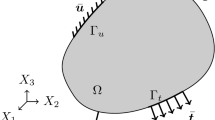Abstract
In this paper, we introduce a homotopy analysis method into the structural reliability analysis and propose a different algorithm from the traditional Hasofer–Lind–Rackwitz–Fiessler type of iterations to solve the reliability index. Due to the powerful function of homotopy analysis in solving nonlinear equations, the method presented in this paper yields high efficiency and strong convergence of the reliability analysis. We first establish the Karush–Kuhn–Tucker (KKT) condition of the optimization problem for reliability index in the first-order reliability method. Next, we construct the corresponding combined homotopy equations for the KKT condition and apply the path-tracking algorithm to efficiently solve the equations. Finally, several numerical examples and an engineering application are provided to validate the effectiveness of the present method.
Similar content being viewed by others
References
Hasofer, A.M., Lind, N.C.: Exact and invariant second-moment code format. J. Eng. Mech. Div. 100(1), 111–121 (1974)
Rackwitz, R., Flessler, B.: Structural reliability under combined random load sequences. Comput. Struct. 9(5), 489–494 (1978)
Hohenbichler, M., Rackwitz, R.: Non-normal dependent vectors in structural safety. J. Eng. Mech. Div. 107(6), 1227–1238 (1981)
Liu, P.L., Der Kiureghian, A.: Optimization algorithms for structural reliability. Struct. Saf. 9(3), 161–177 (1991)
Zhang, Y., der Kiureghian, A.: Two improved algorithms for reliability analysis. In: Rackwitz, R., et al. (eds) Reliability and Optimization of Structural Systems. Proceedings of the Sixth IFIP WG7.5 Working Conference on Reliability and Optimization of Structural Systems. Assisi, Italy (1995)
Lee, J.O., Yang, Y.S., Ruy, W.S.: A comparative study on reliability-index and target-performance-based probabilistic structural design optimization. Comput. Struct. 80(3), 257–269 (2002)
Yang, D., Li, G., Cheng, G.: Convergence analysis of first order reliability method using chaos theory. Comput. Struct. 84(8), 563–571 (2006)
Yang, D.: Chaos control for numerical instability of first order reliability method. Commun. Nonlinear. Sci. 15(10), 3131–3141 (2010)
Zhang, Z.: Computing reliability index of structure by use of Lagrange multiplier method. Eng. Mech., 11(1), 90–98 (1994) (in Chinese)
Li, G., Cheng, G.D.: Performance-based seismic design of structures, method and application. Science Press, Beijing (2004). (in Chinese)
Gong, J.X.: Engineering Structural Reliability Calculation Method. Dut. Press, Dalian (2003). (in Chinese)
Kang, Z., Luo, Y.J.: A modified iteration algorithm for structural reliability index evaluation. Eng. Mech. 25(11), 20–26 (2008) (in Chinese)
Liu, P.L., Der Kiureghian, A.: Multivariate distribution models with prescribed marginals and covariances. Probab. Eng. Mech. 1(2), 105–112 (1986)
Madsen, H.O., Krenk, S., Lind, N.C.: Methods of Structural Safety, Prentice-Hall, Englewood Cliffs, NJ (1986)
Kellogg, R.B., Li, T.Y., Yorke, J.: A constructive proof of the Brouwer fixed-point theorem and computational results. SIAM. J. Numer. Anal. 13(4), 473–483 (1976)
Watson, L.T.: Theory of globally convergent probability-one homotopies for nonlinear programming. SIAM. J. Optim. 11(3), 761–780 (2001)
Smale, S.: A convergent process of price adjustment and global Newton methods. J. Math. Econ. 3(2), 107–120 (1976)
Chow, S.N., Mallet-Paret, J., Yorke, J.A.: Finding zeroes of maps: homotopy methods that are constructive with probability one. Math. Comput. 32(143), 887–899 (1978)
Karmarkar, N.: A new polynomial-time algorithm for linear programming. In: Proceedings of the Sixteenth Annual ACM Symposium on Theory of Computing, pp. 302–311. ACM (1984)
Allgower, E.L., Georg, K.: Numerical Continuation Methods. Springer, Berlin (1990)
Liao, S.J.: An explicit, totally analytic approximate solution for Blasius’ viscous flow problems. Int. J. Nonlinear. Mech. 34(4), 759–778 (1999)
Lin, Z.H., Li, Y., Yu, B.: A combined homotopy interior point method for general nonlinear programming problems. Appl. Math. Comput. 80(2), 759–778 (1996)
Lin, Z.H., Yu, B., Feng, G.C.: A combined homotopy interior point method for convex nonlinear programming. Appl. Math. Comput. 84(2), 193–211 (1997)
Jiang, C., Deng, S.L.: Multi-objective optimization and design considering automotive high-speed and low-speed crashworthiness, Chinese. J. Comput. Mech. 31(4), 471–479 (2014) (in Chinese)
Marzougui, D., Samaha, R.R., Cui, C.: Extended Validation of the Finite Element Model for the 2010 Toyota Yaris Passenger Sedan. Working Paper, NCAC 2012-W-005 (2012)
Author information
Authors and Affiliations
Corresponding author
Rights and permissions
About this article
Cite this article
Jiang, C., Han, S., Ji, M. et al. A new method to solve the structural reliability index based on homotopy analysis. Acta Mech 226, 1067–1083 (2015). https://doi.org/10.1007/s00707-014-1226-x
Received:
Revised:
Published:
Issue Date:
DOI: https://doi.org/10.1007/s00707-014-1226-x




